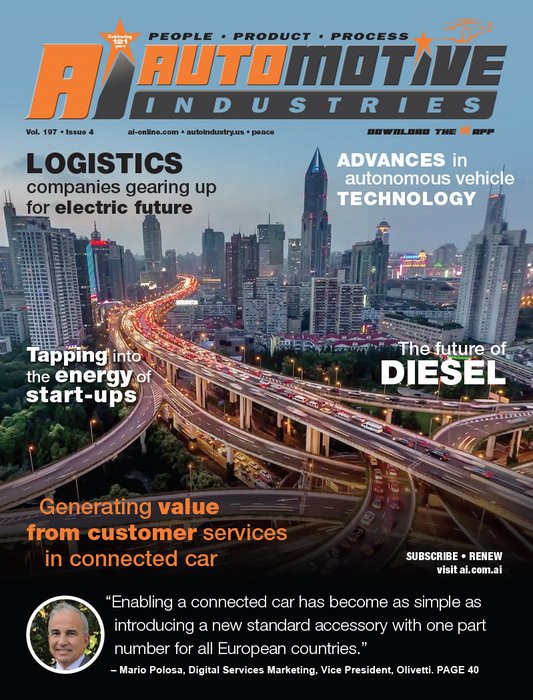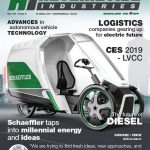It is recognized that OEMs have to change their business models for the industrialized world, where car ownership is being complemented by sharing and improved public transport networks, as well as the electric vehicle.
Sales of vehicles will be supported by the introduction of entertainment, information and other services enabled by the connected car – providing the OEM retains control of the connected services – and in the process increasing the perceived value of the car. One of the companies which has developed a solution is Olivetti of Italy. “In the connected society, the quantity of data arriving from sensors and control objects for the purpose of archiving, analysing and processing information of importance to businesses, and is growing at an exponential rate. This opens up new possibilities where the data and information gathered by objects will lead to a greater awareness and interaction with the surrounding environment, and consequentially lead to changes and improvements in life styles, working practices and business models,” says the company.
Perhaps best known for its office equipment, Olivetti is also a leading player in the field of M2M (machine-to-machine) managed connectivity services. It provides high quality network coverage in all radio technologies, ranging from 2G to 4G/LTE and narrowband IoT. Millions of sim cards have been supplied to utilities for smart metering, insurance companies and telematic service providers for fleet management and digital connected insurance policies, and many other uses. Olivetti has developed a management platform powered by Cisco Jasper,
Automotive Industries (AI) asked Mario Polosa, Digital Services Marketing, Vice President, Olivetti, what the main challenges are to generating value from the connected car.
Polosa: The biggest challenge of all car makers and brands in the last two or three years has been the deployment of a connected car strategy. The path to a connected car is not easy because design and development cycles in the car industry are typically longer than the ICT sector, where products are launched and updated more than once a year following the latest technological developments.
Looking at the European market, the first wave of connected cars – with few exceptions – has been launched by integrating the telco component into the head units of the car. While significant changes had to be made to the hardware, the introduction of connectivity for telematics is relatively easy. However, providing infotainment services is complicated by the fragmentation of markets and mobile operators in the served footprint. Moreover, the mobile consumer market evolves at a speed that is incompatible with the typical speed of the car market. From the ICT and telco perspective this is a huge opportunity to generate new value and new revenue streams for both the car maker and the connected car solution providers.
AI: What should the approach be?
Polosa: Having the right vision is the key. Some time before the enabling technologies were market ready, Olivetti and TIM (its parent company) developed a future proof solution based on 4G/LTE connectivity, which would provide enough bandwidth for the services portfolio that was envisaged at the beginning of the project for one of the top five OEM brands in the world. Another key aspect is the co-design approach, which allows the merging of all competences and enables all participants to better understand the big picture and design a better solution.
AI: Can you describe the solution Olivetti has developed?
Polosa: Let’s start from the customer viewpoint, therefore the services. There are several types of services needed in a connected car. The car maker wants to be closer to the car owner to better understand the needs of its customers. What happens today is that once the car is sold the contact with the end customer is based on maintenance appointments (which may take place once a year). This is clearly not enough to understand how to make a customer happy and how to be the preferred choice for his or her next car selection.
Information coming from the car, such as alarms, key parameters, distances driven and driving behaviors would be the best mix to know how the customer is using the car and how to make a better car. Telematic services are also the enabler for digital insurance programs and new business models where leasing is progressively being complemented or replaced by pay as you drive models.
Connected navigation and Points of Interest are “must have” in the new head units, but also Internet in the car is becoming more and more common. The latest addition to in-car services is represented by third party applications like Internet radio, music, videos and games, or even audio books. These services are common in the mobile user bouquet, and the car could provide added value, such as allowing different passengers to use them at the same time.
The keys to all this are to design a customer experience that is as simple as possible, and to activate, renew, use and make available to all passengers the rich bundle of services available in the connected car. And, behind the scenes, there needs to be a flexible accounting system which can support a variety of business models to manage B2B, B2C and B2B2C services. AI: Does this transformation imply significant changes in the car maker process?
Polosa: The solution developed by Olivetti has contributed to a significant digital transformation in the value chain. The complex system consisting of a number of components needed to power up the connected car has been simplified and brought down to a “service as a product”. Enabling a connected car has become as simple as introducing a new standard accessory with a single part number for all European countries. It can, therefore, be managed by the value chain in a “business as usual” model. After the car is sold everything is managed through a portal and a mobile app where the user can monitor the use of the service, buy new service packages, refill its navigation bundle and drive the car all around Europe taking advantage of recently introduced Roam like at Home service. Of course, there is a lot of work behind this.
AI: and from the technical standpoint?
Polosa: Behind a very simple and smooth customer experience there is an evolved high-tech infrastructure. It is based on an original idea and project designed by Olivetti, which utilizes all state-of-the-art components in the IT and IoT space in order to build a very advanced business automation platform which simplifies life for the end user and car owner, for the car maker, for the dealer and for Olivetti itself which is managing the service on behalf of the car maker.
APIs, cloud and managed connectivity are the key ingredients to create the connected car environment. A cloud automation engine, driven by a completely API-based customized application software interacts with the customer portal and with the M2M back-end system. The customer portal is exactly the same that is being used for managing the car, providing map updates, monitoring maintenance programs, etc. Different European mobile network operators have provided the interfaces to their specific M2M platforms to provision services for telematics, infotainment, connectivity and car specific features through the back end.
The other core component of the project is a customized project of an automotive grade 4G/LTE onboard device which incorporates a telematics box, a wireless router, a firmware update interface and Bluetooth/Wi-Fi radio interfaces in the car. It has been designed and integrated by the Italian company Avmap, a partner with strong expertise in the automotive. A 3GPP standard embedded eUICC (eSIM) gives life to the device. It is remotely operated and provisioned by Olivetti, based on the customer specific profile, which assigns the right country of use and the market-specific service packages that the car brand has selected for the local market and for the car model/grade.
AI: I understand that you have been leveraging cloud and APIs extensively for the solution. Where are the benefits?
Polosa: The solution has been developed utilizing mostly cloud platforms connected through APIs. Therefore, the advanced architecture can be re-used and applied in many other commercial scenarios and business opportunities enabled by mobile connectivity and advanced management functionalities. Potentially any mobility player, from digital insurance companies to dealers and customer support centers, to car sharing companies including of course car makers, both for new cars and aftermarket options, could benefit from the platform which provides Europe-wide connectivity for all types of services. The second advantage is that the architecture can easily integrate new platforms and services where and when needed, therefore evolving according to the market needs.
















































 Shifting gear from agricultural domination to trucks, passenger and sportscars
Shifting gear from agricultural domination to trucks, passenger and sportscars Solid-state LiDAR technology being fine tuned in the field
Solid-state LiDAR technology being fine tuned in the field Port flips the switch on investment to handle electric vehicles
Port flips the switch on investment to handle electric vehicles Germain Racing speeds up design cycle using cloud-based CFD system
Germain Racing speeds up design cycle using cloud-based CFD system Moving at the speed of light towards the car of the future
Moving at the speed of light towards the car of the future Schaeffler staying ahead of technology curve by partnering with innovative start-ups
Schaeffler staying ahead of technology curve by partnering with innovative start-ups


